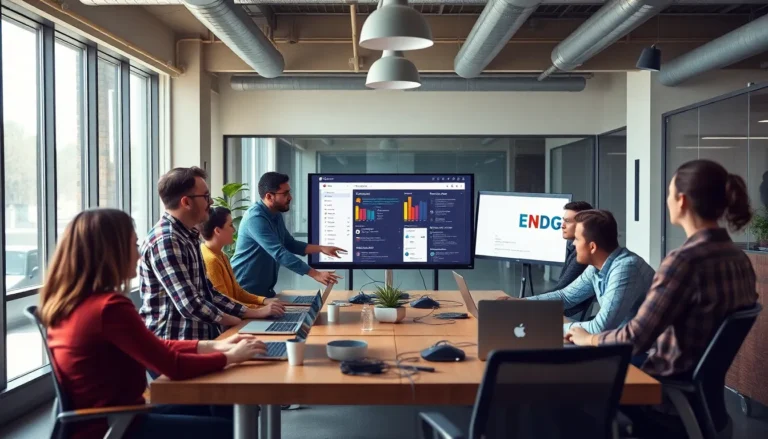Table of Contents
ToggleIn a world where food delivery apps are just a tap away and lab-grown burgers are becoming a reality, food tech innovations are shaking up the culinary scene like never before. Imagine a future where your fridge knows when you’re out of milk and orders more for you while you binge-watch your favorite series. Sounds like sci-fi? Well, it’s happening now!
Overview of Food Tech Innovations
Food technology continues to reshape how society approaches cooking, dining, and food production. Significant progress in areas like lab-grown meat provides sustainable alternatives to traditional livestock farming. Innovations in food delivery apps streamline the process of ordering meals, making it easier than ever for consumers to access diverse cuisines.
Smart appliances play a crucial role in modern kitchens. Refrigerators now equipped with AI capabilities can monitor inventory levels and automatically reorder essentials, eliminating the hassle of grocery shopping. Additionally, automated cooking devices simplify meal prep, allowing users to focus on enjoying their food.
Vertical farming represents another exciting advancement in food tech. This method enables the production of fresh produce in urban environments, reducing the distance food travels from farm to table. By utilizing controlled environments, vertical farming optimizes resource use, minimizing water and land consumption.
Blockchain technology enhances food traceability and safety. With this innovation, consumers can track the origin of their food products, ensuring transparency in the supply chain. Enhanced data security fosters trust between consumers and producers.
Plant-based alternatives continue to gain popularity as consumers seek healthier and more environmentally friendly options. Companies are developing innovative substitutes, from dairy to meat, that cater to a growing market of plant-based diets.
Overall, food tech innovations are paving the way for a more efficient, sustainable, and transparent food industry. These advancements not only address current challenges but also lay the groundwork for future culinary experiences.
Key Drivers of Food Tech Innovations

Food tech innovations arise from several key factors that shape the industry landscape today. Two primary drivers include sustainability and consumer demand.
Sustainability
Sustainability in food tech encompasses efforts to reduce environmental impact. Innovations such as lab-grown meat significantly lower greenhouse gas emissions compared to traditional livestock farming. Vertical farming optimizes space and resource use while producing fresh produce in urban areas. These advancements promote efficient water use and soil conservation, contributing to a greener food system. Companies increasingly prioritize sustainable practices, driven by both regulatory pressures and growing public awareness. As a result, consumers now favor brands that commit to environmentally responsible methods. This change signals a vital shift towards a sustainable future in the food industry.
Consumer Demand
Consumer demand plays a crucial role in accelerating food tech innovations. Shifts in dietary preferences create opportunities for companies to develop plant-based alternatives and novel food solutions. Individuals increasingly seek convenience, leading to a rise in food delivery apps and smart kitchen appliances. Customizable meal kits cater to diverse tastes and dietary restrictions, enhancing user experience. Health-conscious consumers show a preference for nutritious options, thereby influencing product formulations and ingredient sourcing. This evolving landscape highlights how consumer priorities shape food technology strategies. Adapting to these trends ensures that businesses remain competitive and relevant in the market.
Notable Food Tech Innovations
Food tech innovations reshape the culinary landscape, presenting solutions that ignite excitement and efficiency in meal preparation and consumption.
Alternative Proteins
Alternative proteins, such as lab-grown meat and plant-based options, lead the charge in sustainable food production. These innovations reduce reliance on traditional livestock farming, decreasing environmental impact while meeting rising consumer demand. Companies like Beyond Meat and Impossible Foods showcase flavorsome alternatives that appeal to meat lovers and vegetarians alike. Research indicates that the market for alternative proteins is projected to reach $27.6 billion by 2025, underscoring their growing significance in the food industry. Shifting dietary preferences toward healthier and environmentally friendly products drives ongoing development in this sector.
Smart Kitchen Appliances
Smart kitchen appliances redefine meal preparation, integrating technology to enhance culinary experiences. Devices like smart fridges and connected ovens simplify cooking and help users manage inventories. These appliances track stock levels and suggest recipes based on available ingredients. Companies continue to innovate, creating products that sync with mobile applications for added convenience. In 2020, the smart kitchen appliance market was valued at $22 billion and is projected to grow substantially, highlighting consumer interest in technology that streamlines cooking. Overall, these innovations promote efficiency and engagement in the kitchen.
Food Delivery Systems
Food delivery systems evolve rapidly, catering to growing consumer demand for convenience. Platforms like Uber Eats and DoorDash facilitate quick access to diverse cuisines, significantly changing how people dine. Over 111 million consumers used food delivery services in the U.S. in 2021, reflecting a shift in eating habits. Additionally, meal kit services provide customizable options that allow users to prepare fresh meals at home effortlessly. Innovations in logistics and technology optimize delivery routes and times, ensuring timely service. As urban lifestyles become more hectic, these food delivery systems remain essential, highlighting an ongoing trend toward convenience in dining.
Impact on the Food Industry
Food technology innovations reshape the food industry profoundly. Lab-grown meat provides a sustainable alternative to traditional livestock farming, significantly reducing environmental impact. Vertical farming offers innovative solutions, producing fresh produce in urban environments while conserving resources. These innovations lead to more efficient food production methods, catering to a growing population with reduced reliance on agricultural land.
Innovative food delivery apps streamline meal ordering. Companies like Uber Eats and DoorDash enhance access to diverse cuisines, meeting consumer demand for convenience. Meal kit services continue to gain traction, appealing to those seeking easy and customizable dining experiences. Customizable offerings reflect changing eating habits and a push for personal choice in meals.
Smart kitchen appliances redefine culinary processes. With the market valued at $22 billion in 2020, these devices integrate technology to monitor inventory and suggest recipes based on available ingredients. AI-powered fridges enhance household convenience by automatically reordering groceries, removing a time-consuming task from daily routines. Cooking becomes a more enjoyable and less stressful experience through such advancements.
Blockchain technology plays a critical role in food safety and traceability. Enhanced tracking systems help build consumer trust by ensuring transparency in food sourcing and production. Producers increasingly implement these technologies to assure customers of safety and quality in their food choices.
The growing popularity of plant-based alternatives reflects a shift toward healthier options. Producers like Beyond Meat and Impossible Foods create appealing products that attract a wide audience. With the alternative protein market projected to reach $27.6 billion by 2025, the emphasis on sustainability remains essential for companies navigating the evolving food landscape.
Future Trends in Food Tech Innovations
Food technology innovations are set to transform the culinary landscape even further. Advancements in artificial intelligence will optimize meal planning and preparation, making cooking more accessible for everyone. Companies are already developing smart appliances that suggest recipes based on the ingredients users have on hand.
Consumer interest in sustainable practices is driving the growth of lab-grown alternatives. Market projections indicate that the alternative protein sector could reach $27.6 billion by 2025. Alongside this, vertical farming technologies are increasing in popularity, allowing fresh produce to thrive in urban environments while minimizing resource consumption.
Enhanced food safety through blockchain technology will provide transparency in the food supply chain. This technology will document every step, from farm to table, ensuring that consumers can trust their food sources. Transparency fosters a stronger connection between producers and consumers.
Meal kit delivery services are evolving, catering to health-conscious individuals seeking convenience. These services offer customizable options that reflect diverse dietary preferences, allowing consumers to enjoy fresh, nutritious meals without extensive preparation. Delivery platforms continue to innovate, with incorporation of AI-driven recommendations to match consumer tastes.
Flexible food systems focusing on plant-based alternatives reflect a significant shift in dietary trends. Companies like Beyond Meat and Impossible Foods lead the charge by offering flavorful options appealing to various audiences. The groundwork laid by these innovations illustrates a clear move towards sustainable, healthy eating habits.
Collaborative efforts between technology and culinary experts will redefine dining experiences. Smart restaurants equipped with integrated systems optimizing service and food preparation will offer unique dining solutions. This synergy between technology and food will shape future culinary trends, enhancing overall consumer satisfaction.
Food tech innovations are revolutionizing the way people interact with food. As advancements continue to emerge, they promise a future that’s not only more convenient but also sustainable. The integration of smart appliances and vertical farming is set to enhance urban living while reducing environmental impact.
With growing consumer demand for healthier and more transparent food options, companies are adapting to meet these needs. The rise of alternative proteins and customizable meal kits reflects a significant shift in dietary preferences, paving the way for a more inclusive culinary landscape.
As technology and culinary arts converge, the food industry is poised for transformation. This evolution will undoubtedly lead to improved dining experiences and a deeper connection between consumers and their food sources.







